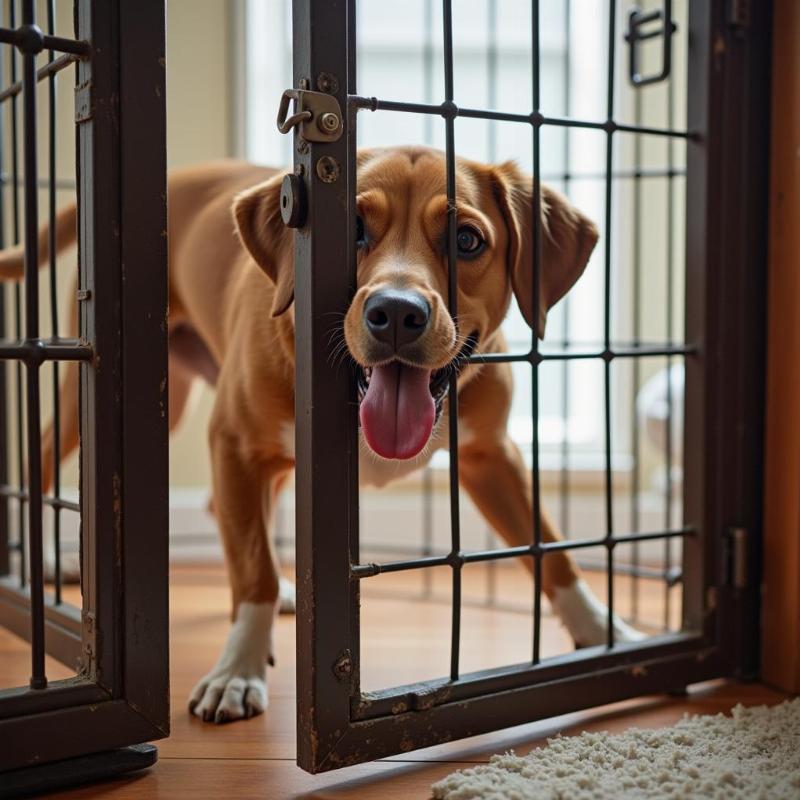Your furry friend’s Houdini-like escapes from their crate can be frustrating and concerning. This comprehensive guide will help you understand why your dog keeps breaking out of crate, offering solutions to create a safe and secure environment for your pup and some much-needed peace of mind for you.
Understanding Why Your Dog Breaks Out
Before tackling the how of preventing escapes, let’s delve into the why. Several reasons contribute to a dog’s crate-breaking behavior, and understanding the root cause is key to finding the right solution. Is it separation anxiety fueling their escape attempts? Are they simply bored and seeking adventure? Perhaps the crate isn’t comfortable enough, or they’re not fully potty trained. Maybe the crate itself is the issue – is it the right size, sturdy enough, and properly secured? Identifying the underlying reason is the first step to addressing this frustrating behavior.
 Dog breaking out of crate due to anxiety
Dog breaking out of crate due to anxiety
Choosing the Right Crate
Selecting the appropriate crate is crucial for your dog’s comfort and security. A crate that is too small restricts movement and can cause discomfort, while one that is too large might allow your dog to designate a potty area inside. Measure your dog carefully, ensuring they can stand up, turn around, and lie down comfortably. Consider the material too – wire crates offer better ventilation, while plastic crates provide a greater sense of security. For determined escape artists, heavy-duty crates designed for strong breeds might be necessary. Remember to introduce the crate gradually and create positive associations with it.
Crate Training: A Step-by-Step Guide
Effective crate training is essential for a dog’s acceptance of their crate. Start by making the crate a comfortable and inviting space. Add soft bedding, a favorite toy, and perhaps a treat-dispensing puzzle. Introduce the crate gradually, allowing your dog to explore it at their own pace. Feed them meals near or inside the crate. Never use the crate as punishment. Positive reinforcement and patience are key.
Addressing Separation Anxiety
If separation anxiety is the culprit behind your dog’s escape attempts, consult with a veterinarian or certified professional dog trainer. They can offer tailored guidance and behavioral modification techniques to help manage your dog’s anxiety. Creating a predictable routine, leaving your dog with familiar items, and providing plenty of exercise before leaving can help alleviate their stress. Consider using pheromone diffusers or calming supplements, always under the guidance of a veterinarian.
Securing the Crate and Preventing Escapes
Sometimes, even with proper training and a suitable crate, a determined dog can find a way out. Ensure all latches and doors are securely fastened. For wire crates, zip ties can provide added security. For particularly persistent escape artists, consider crate covers, which can create a den-like environment and reduce anxiety. Supervise your dog initially when they are crated to ensure they are not actively trying to escape.
Conclusion
A dog consistently breaking out of their crate can be a challenge, but with patience, understanding, and the right approach, you can create a safe and secure environment for your furry companion. Addressing the underlying cause, whether it’s boredom, anxiety, or simply a need for better training, is key to solving this issue. Remember, a secure and comfortable crate is not a punishment but a safe haven for your dog.
FAQ
- My dog seems stressed in their crate. What should I do? Ensure the crate is the right size and provides a comfortable environment. Introduce the crate gradually and use positive reinforcement. If anxiety persists, consult a veterinarian or professional dog trainer.
- What type of crate is best for a dog that escapes? Heavy-duty wire or plastic crates designed for strong breeds are often more secure for escape artists.
- How long should I leave my dog in their crate? Crate time should be gradual, starting with short periods and increasing as your dog becomes more comfortable.
- Can I use a crate for punishment? Never. The crate should be a positive and safe space for your dog.
- My dog keeps barking and whining in their crate. What can I do? Address any potential underlying causes such as separation anxiety or boredom. Provide enrichment activities and ensure they have been properly exercised before crating.
Relevant Articles
Beautdogs.us is your premier destination for all things dog-related in the US. We provide expert advice, breed-specific information, and product recommendations to help you provide the best possible care for your canine companion. Whether you’re a seasoned dog owner or a first-timer, Beautdogs.us is your trusted source for comprehensive and engaging information on dog care and companionship. Contact us for expert advice! Email: [email protected], Phone: +1 501-555-7529.